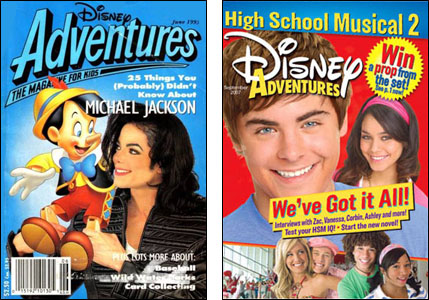
Discussions of what's wrong with the comic book industry and how to make things better often strike me as talking all around the pachyderm in the parlor — the fact that fewer and fewer potential customers out there are warm to the idea of buying a thing on paper called a comic book or magazine. In an era of Internet and home video and video gaming, one can get plenty of material that more or less parallels what comics have to offer…and you can get it with sound and with animation, and you can get it in your home without leaving your chair, and you can often get it for free. With that in mind, the news that Disney Adventures magazine is ending after seventeen years oughta throw another scare into lovers of hardcopy comics and other publications.
Every panel I've ever been on about the future of comics has included the wish-dream that our form would reach out to younger readers and find new methods of distribution apart from the traditional funnybook racks. Well, Disney Adventures connected with younger readers and achieved a superior market penetration. The problem was not that you couldn't find it. It was easily available at supermarket checkout stands, right next to the National Enquirer and the Altoids. When TV Guide got away from its old digest format, Disney Adventures picked up a lot of those spots, as well. The problem was that advertisers didn't see it as a dandy place to advertise. Even with a million-plus circulation — numbers that any comic book publisher today would kill for — the people behind Disney Adventures couldn't make the math work.
No one who loves the concept of paper magazines should conclude the form is doomed to extinction but we also shouldn't ignore a very real market trend here. Once upon a time, Playboy sold seven million copies per issue and now it sells three million. This is not because of a declining male interest in beautiful nude women or because the women aren't as beautiful or as nude as they used to be. It's because you can now get those beautiful nude women on the Internet or on DVD and maybe they're even better in that venue. The same thing is true of Spider-Man comic books and the Spider-Man movies. Before about 1985, when a comic book character became a movie or TV show, that promoted the comic book and sales skyrocketed. In the last few decades though, it almost seems to work the other way around. If kids can get a great animated Batman for free on TV, they don't need to go out and buy the comic.
It's worth noting that increasingly, Disney Adventures downplayed its comic strip content and sold by promoting the current hot movie, the current hot TV show, the current hot video game, etc. More than a million copies per issue were purchased but they were sold because consumers were interested in Harry Potter or High School Musical or Justin Timberlake. They didn't care about a paper magazine except as an adjunct to the stuff they really cared about.
Obviously, Disney Adventures was not a comic book. It was a kids' magazine that had comic book content — and less and less of it over the years, it seemed. But it's still worrisome that its publishers are folding it and saying they want to "…better focus resources and maximize long-term growth potential through new magazine and book initiatives." That roughly translates to: "We need to figure out if there's a way to make money publishing paper magazines these days." I sure hope someone finds one.